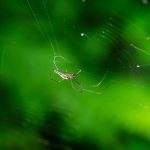Chanderi silk is a lightweight, sheer fabric from Madhya Pradesh, India, dating back to the 13th century. You’ll notice its smooth texture and subtle sheen, crafted through traditional handloom weaving using silk blended with cotton or zari threads. It features delicate, nature-inspired motifs like peacocks and lotuses, embodying rich heritage and elegance. Unlike heavier silks, it offers breathable comfort with graceful drape. Keep exploring to uncover how its unique weave and patterns make it truly special.
Table of Contents
Key Takeaways
- Chanderi silk originated in the 13th century in Madhya Pradesh, symbolizing elegance and royal heritage.
- It is woven on handlooms using silk blended with cotton or zari, creating a lightweight and sheer fabric.
- The weave features shimmering zari threads, delicate motifs inspired by nature and Mughal art, and a smooth yet slightly textured finish.
- Chanderi silk is distinct for its lightweight, translucent quality and subtle patterns compared to heavier, bolder Indian silks.
- It offers breathable comfort with graceful drape, suitable for weddings, festivals, casual wear, and elegant styling.
The Origins and Historical Significance of Chanderi Silk
Chanderi silk has fascinated weavers and wearers for centuries, thanks to its rich history and unique craftsmanship.
Chanderi silk captivates with centuries of tradition and exquisite artisanal weaving.
When you explore its origins, you’ll find it traces back to the town of Chanderi in Madhya Pradesh, India, dating as far back as the 13th century. This fabric has always symbolized elegance and status, often chosen for royal and ceremonial attire.
You’ll appreciate how Chanderi silk blends silk with cotton or zari, creating a lightweight, sheer textile that’s both durable and graceful.
Over time, it became a cultural emblem, representing the heritage and artistry of Indian weaving communities.
Understanding this background helps you truly value the fabric’s place in history and why it remains a cherished choice today.
Traditional Techniques Used in Chanderi Weaving
You’ll appreciate how Chanderi weaving relies on handloom techniques that bring out its unique texture.
The use of shimmering zari threads adds elegance and tradition to each piece.
Plus, the careful dyeing and finishing methods guarantee the silk’s vibrant colors and lasting quality.
Handloom Weaving Process
Although the handloom weaving process demands patience and skill, it lets artisans create the delicate patterns that define this silk fabric.
When you watch Chanderi silk being woven, you’ll notice how the weaver carefully interlaces the fine silk and cotton threads on the loom, maintaining tension and precision. You control the shuttle, passing it through warp threads methodically, ensuring each pass aligns perfectly with the design.
This slow, rhythmic motion helps you achieve the fabric’s signature lightness and translucency. You’ll also see how the weaver uses simple tools to adjust the pattern row by row, creating intricate motifs without shortcuts.
This hands-on approach preserves the traditional essence and quality that machine-made fabrics can’t replicate.
Use of Zari Threads
The intricate patterns you see in the fabric come alive with the addition of zari threads, which artisans skillfully weave alongside silk and cotton.
When you examine Chanderi silk closely, you’ll notice these fine metallic threads add a subtle shimmer, highlighting motifs like floral designs and geometric shapes.
Zari threads are traditionally made from gold or silver, but modern weavers often use copper coated with gold or silver to maintain affordability.
As you watch the weaver work, you’ll appreciate how they interlace zari with the base yarn on handlooms, ensuring the thread remains secure yet flexible.
This technique requires precision and patience, preserving the fabric’s lightweight feel while enriching its visual appeal.
You’ll find that zari work defines Chanderi silk’s signature elegance.
Dyeing and Finishing Methods
When artisans prepare Chanderi silk for weaving, they rely on traditional dyeing and finishing methods that have been passed down through generations.
You’ll find that natural dyes, derived from plants and minerals, are often used to create vibrant yet subtle shades. These eco-friendly dyes not only enhance the silk’s natural sheen but also guarantee color longevity.
After dyeing, the fabric undergoes a soft finishing process, which includes careful washing and sun-drying, preserving its lightweight and translucent nature. This delicate treatment helps retain the silk’s characteristic airy texture and smooth feel.
Distinctive Features of Chanderi Silk Fabric
You’ll notice Chanderi silk stands out with its unique texture and natural sheen that catches the light beautifully.
Its traditional motifs and patterns add a timeless charm that reflects rich cultural heritage.
Let’s explore what makes this fabric truly special.
Texture and Sheen
Chanderi silk captivates with its unique texture that feels both lightweight and smooth against your skin. When you wear it, you immediately notice how airy and breathable the fabric is, making it perfect for warm climates.
The silk’s fine weave creates a delicate yet durable material that drapes elegantly, enhancing your silhouette without feeling heavy. Its subtle sheen catches the light softly, giving the fabric a natural glow that looks sophisticated without being flashy.
This gentle lustre comes from the high-quality silk threads combined with traditional weaving techniques. As you move, the fabric’s shimmer shifts, adding depth and richness to its appearance.
You’ll appreciate how this combination of texture and sheen sets Chanderi silk apart from other fabrics.
Traditional Motifs and Patterns
The subtle sheen and delicate texture of this silk provide the perfect canvas for its traditional motifs and patterns.
When you look closely, you’ll notice classic designs like floral vines, geometric shapes, and peacocks, each woven with intricate detail.
These motifs aren’t random; they carry cultural significance, often inspired by nature and local folklore.
You’ll also see the use of zari threads, which add a shimmering contrast to the silk base, enhancing the elegance.
As you wear or admire Chanderi silk, these patterns tell a story of craftsmanship passed down through generations.
They give the fabric its unique identity, setting it apart from other silks.
Embracing these traditional motifs connects you to centuries of Indian heritage and artistry.
Common Motifs and Patterns in Chanderi Designs
Intricate motifs and patterns define the timeless charm of Chanderi designs. When you look closely, you’ll notice classic elements like floral patterns, paisleys, and geometric shapes woven with precision.
These motifs often draw inspiration from nature and Mughal art, giving Chanderi silk its elegant and graceful appeal. You’ll also find designs featuring peacocks, lotuses, and vines, which symbolize beauty and prosperity.
The patterns are typically arranged in a balanced, symmetrical way, enhancing the fabric’s visual harmony. As you explore Chanderi silk, you’ll appreciate how these common motifs not only showcase skilled craftsmanship but also carry cultural significance, making each piece a unique blend of artistry and tradition.
Differences Between Chanderi Silk and Other Indian Silks
While many Indian silks share a rich heritage, you’ll find that Chanderi silk stands out because of its lightweight texture and sheer quality.
Unlike Banarasi silk, which is heavier and features dense zari work, Chanderi offers a delicate, airy feel ideal for warmer climates.
Chanderi silk’s delicate, airy texture makes it perfect for warm weather, unlike the heavier Banarasi silk.
Paithani silks tend to have bold, intricate motifs and a heavier weave, whereas Chanderi embraces subtle patterns with a translucent finish.
You’ll also notice that Mysore silk has a smooth, glossy surface, contrasting with Chanderi’s slightly textured weave that combines silk with fine cotton or zari threads.
This unique blend gives Chanderi its signature softness and shimmering elegance, setting it apart from other regional silks known for their richness or opulence rather than lightness and grace.
How to Identify Authentic Chanderi Silk
When you want to verify you’re buying genuine Chanderi silk, pay close attention to its texture and weave.
Authentic Chanderi silk feels lightweight and sheer, yet has a rich, slightly glossy finish. The weave should be fine and intricate, showcasing traditional motifs like coins, flowers, or peacocks in gold or silver zari threads.
Run your fingers over the fabric; it should feel smooth with a subtle crispness, not rough or overly soft like synthetic blends. Check the selvedge edges—they’re tightly woven and clean.
Also, authentic Chanderi silk drapes elegantly without stiffness. Avoid pieces that look too shiny or have inconsistent patterns, as these might be machine-made or blended fabrics.
Trust credible sellers who source directly from Chanderi artisans to verify authenticity.
Styling Tips and Occasions to Wear Chanderi Silk
Because Chanderi silk combines elegance with comfort, you can style it for both traditional ceremonies and contemporary events.
When choosing your outfit, consider the occasion and how you want to express yourself. You can go classic or add a modern twist.
Here are some styling tips and occasions perfect for Chanderi silk:
- Pair a Chanderi saree with minimal jewelry for weddings or religious festivals.
- Wear a Chanderi kurta with palazzos for casual gatherings or office parties.
- Opt for a Chanderi dupatta over a simple suit to elevate everyday wear.
- Style a Chanderi lehenga with statement accessories for receptions or cultural events.
With these options, you’ll look effortlessly graceful while enjoying the breathable and luxurious feel of Chanderi silk.
Frequently Asked Questions
How Should Chanderi Silk Be Cared for and Cleaned?
You wouldn’t want to throw Chanderi silk in a washing machine, right? Instead, you should dry clean it or hand wash gently in cold water, avoiding harsh detergents to keep its delicate texture and sheen intact.
What Is the Price Range of Chanderi Silk Sarees?
You’ll find Chanderi silk sarees priced between $50 and $500, depending on the intricacy, fabric quality, and designer. Remember, handwoven pieces with detailed work usually cost more, reflecting their craftsmanship and uniqueness.
Are There Eco-Friendly or Sustainable Chanderi Silk Options?
You can find eco-friendly Chanderi silk options made with organic silk and natural dyes. Choosing these supports sustainable practices, reduces environmental impact, and helps preserve traditional craftsmanship while keeping your wardrobe stylish and responsible.
Can Chanderi Silk Be Used for Home Décor Items?
Imagine your home wrapped in a gentle silk hug—yes, you can use Chanderi silk for cushions, curtains, or table runners. Its delicate sheen adds elegance, turning everyday spaces into timeless works of art you’ll love.
Where Can I Buy Authentic Chanderi Silk Online?
You can buy authentic Chanderi silk online from trusted websites like Fabindia, Amazon, and Craftsvilla. Always check seller reviews and product details to verify you’re getting genuine fabric with traditional craftsmanship.
- What Is Pochampally Ikat? a Journey to India’s Silk City - June 27, 2025
- What Is Pochampally Ikat? a Journey to India’s Silk City - June 27, 2025
- What Is Pochampally Ikat? a Journey to India’s Silk City - June 27, 2025







